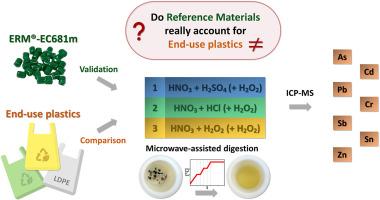统一传统塑料和可堆肥塑料中的金属(loid)分析:低密度聚乙烯和 PBAT/TPS 混合物中酸性消化方案的比较。
IF 8.1
2区 环境科学与生态学
Q1 ENVIRONMENTAL SCIENCES
引用次数: 0
摘要
通过酸消化规程分析塑料材料中的含金属添加剂以解决潜在的环境影响问题已引起越来越多的关注。然而,由于缺乏统一的方案,妨碍了文献中数据的可比性。在此,我们采用了六种酸消解方案来测定塑料中的金属(loid)含量:其中包括三种不同的酸混合物(HNO3 与 H2SO4、HCl 或 H2O2 混合),用于微波辅助消解,可选择是否使用 H2O2 进行额外的室温消解步骤。首先使用低密度聚乙烯(LDPE)认证参考材料(ERM®-EC681m)对每种方案的七种金属(惰性气体)(砷、镉、铬、铅、锑、锡和锌)进行验证。然后,将经过验证的方案应用于最终使用材料,包括传统塑料(即 LDPE)和可堆肥塑料(即 PBAT/TPS)。H2SO4 和 HNO3 的组合以及 H2O2 的进一步消化步骤是最合适的方案:它成功地通过了所有金属(loid)的验证阈值(回收率在 98.6 - 101.0 % 之间),并在最终使用材料中产生了最高的浓度。所有其他方案都会降低样品基质的消化效率,导致回收率降低并形成固体残留物。值得注意的是,最终使用塑料中的金属(loid)浓度变化很大,这可能是由于其成分中含有大量添加剂,而参照材料中的酸溶性添加剂含量极低。这项研究为统一酸消化规程迈出了第一步,同时也凸显了由于塑料添加剂成分复杂,准确分析最终使用塑料材料所面临的新挑战。本文章由计算机程序翻译,如有差异,请以英文原文为准。

Towards harmonization of metal(loid)s determination in conventional and compostable plastics: Comparison of acid digestion protocols in LDPE and PBAT/TPS blends
The determination of metal-containing additives in plastic materials via acid digestion protocols has attracted growing interest to address potential environmental implications. However, the lack of protocol harmonization hinders data comparability within the literature. Here, six acid digestion protocols were employed to determine the metal(loid) content in plastics: these included three different acid mixtures (HNO3 combined with H2SO4, HCl or H2O2) for microwave-assisted digestion, with or without an additional room-temperature digestion step with H2O2.
Each protocol was first validated for seven metal(loid)s (As, Cd, Cr, Pb, Sb, Sn and Zn) using a low-density polyethylene (LDPE) certified reference material (ERM®-EC681m). Then, validated protocols were applied on end-use materials, including conventional (i.e., LDPE) and compostable (i.e., PBAT/TPS) plastics.
The combination of H2SO4 and HNO3 with a further digestion step with H2O2 was the most suitable protocol: it successfully passed validation thresholds for all metal(loid)s (recoveries in the range 98.6–101.0 %) and yielded the highest concentrations in end-use materials. All other protocols resulted in a less efficient digestion of the sample matrix, leading to lower recoveries and the formation of solid residues. Notably, end-use plastics showed a great variability in metal(loid) concentrations, likely due to their additive-rich composition, in contrast to the minimal content of acid-soluble additives of the reference material.
This study represents an initial step towards the harmonization of acid digestion protocols and highlights new challenges in accurately analyzing end-use plastic materials, due to their complex additive composition.
求助全文
通过发布文献求助,成功后即可免费获取论文全文。
去求助
来源期刊

Chemosphere
环境科学-环境科学
CiteScore
15.80
自引率
8.00%
发文量
4975
审稿时长
3.4 months
期刊介绍:
Chemosphere, being an international multidisciplinary journal, is dedicated to publishing original communications and review articles on chemicals in the environment. The scope covers a wide range of topics, including the identification, quantification, behavior, fate, toxicology, treatment, and remediation of chemicals in the bio-, hydro-, litho-, and atmosphere, ensuring the broad dissemination of research in this field.
 求助内容:
求助内容: 应助结果提醒方式:
应助结果提醒方式:


